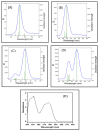Synthesis of 4-Amino- N-[2 (diethylamino)Ethyl]Benzamide Tetraphenylborate Ion-Associate Complex: Characterization, Antibacterial and Computational Study
- PMID: 36903501
- PMCID: PMC10005259
- DOI: 10.3390/molecules28052256
Synthesis of 4-Amino- N-[2 (diethylamino)Ethyl]Benzamide Tetraphenylborate Ion-Associate Complex: Characterization, Antibacterial and Computational Study
Abstract
The 4-amino-N-[2 (diethylamino) ethyl] benzamide (procainamide)-tetraphenylborate complex was synthesized by reacting sodium tetraphenyl borate with 4-amino-N-[2 (diethylamino) ethyl] benzamide, chloride salt, and procainamide in deionized water at room temperature through an ion-associate reaction (green chemistry) at room temperature, and characterized by several physicochemical methods. The formation of ion-associate complex between bio-active molecules and/or organic molecules is crucial to comprehending the relationships between bioactive molecules and receptor interactions. The solid complex was characterized by infrared spectra, NMR, elemental analysis, and mass spectrometry, indicating the formation of ion-associate or ion-pair complex. The complex under study was examined for antibacterial activity. The ground state electronic characteristics of the S1 and S2 complex configurations were computed using the density functional theory (DFT) approach, using B3LYP level 6-311 G(d,p) basis sets. R2 = 0.9765 and 0.9556, respectively, indicate a strong correlation between the observed and theoretical 1H-NMR, and the relative error of vibrational frequencies for both configurations was acceptable, as well. HOMO and LUMO frontier molecular orbitals and molecular electrostatics using the optimized were used to obtain a potential map of the chemical. The n → π* UV absorption peak of the UV cutoff edge was detected for both configurations of the complex. Spectroscopic methods were structures used to characterize the structure (FT-IR and 1HNMR). In the ground state, DFT/B3LYP/6-311G(d,p) basis sets were used to determine the electrical and geometric properties of the S1 and S2 configurations of the title complex. Comparing the observed and calculated values for the S1 and S2 forms, the HOMO-LUMO energy gap of compounds was 3182 and 3231 eV, respectively. The small energy gap between HOMO and LUMO indicated that the compound was stable. In addition, the MEP reveals that positive potential sites were around the PR molecule, whereas negative potential sites were surrounding the TPB site of atoms. The UV absorption of both arrangements is comparable to the experimental UV spectrum.
Keywords: antibacterial activity; characterization; computational study; ion-associate complex; procainamide; tetraphenyl borate.
Conflict of interest statement
There is no conflict interest in this work.
Figures









References
-
- Rogers R.D., Seddon K.R., Division of Industrial and Engineering Chemistry Staff American Chemical Society. Meeting Staff American Chemical Society . Ionic Liquids as Green Solvents. ACS Publications; Washington, DC, USA: 2003.
-
- Seddon K.R., Stark A., Torres M.-J. Influence of chloride, water, and organic solvents on the physical properties of ionic liquids. Pure Appl. Chem. 2000;72:2275–2287. doi: 10.1351/pac200072122275. - DOI
Grants and funding
LinkOut - more resources
Full Text Sources
Research Materials
Miscellaneous

